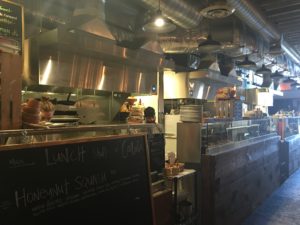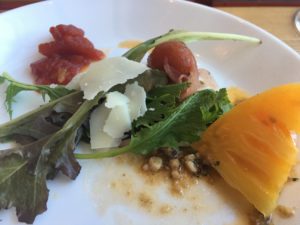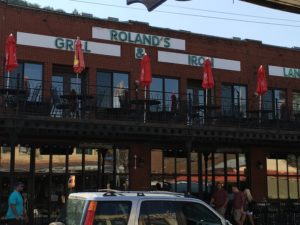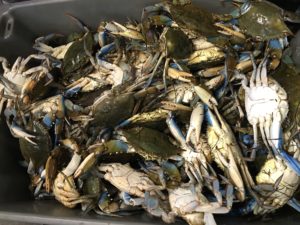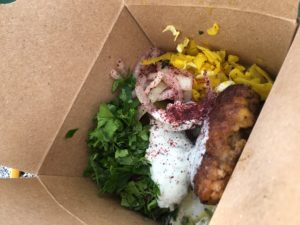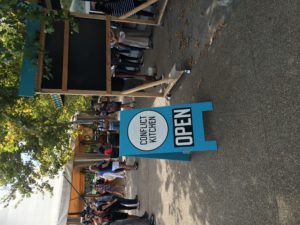Heinz. Duquesne. PPG. Brats. Pierogi. Neighborhoods. Primanti sandwich. “Pittsburgh left.” Bridges.
 There’s something about Pittsburgh. It was the big city across the bridge from the little town I visited as a kid, playing and biking the “Old Road” with eight cousins in summertime. Granny and Grandad ‘s beer garden there was dream-like, because of their open arms and laps plus homemade ravioli, gnocchi and rolls, huge Hershey bars and long pretzel sticks from a canister at the dark, mysterious bar.
There’s something about Pittsburgh. It was the big city across the bridge from the little town I visited as a kid, playing and biking the “Old Road” with eight cousins in summertime. Granny and Grandad ‘s beer garden there was dream-like, because of their open arms and laps plus homemade ravioli, gnocchi and rolls, huge Hershey bars and long pretzel sticks from a canister at the dark, mysterious bar.
On a four-day trip to the city in early September, I found the Biergarten on the roof of the marvelous Hotel Monaco and verified Pittsburgh is still all about homemade, ethnic, make-you-swoon food and libations. And more.
The culinary scene has exploded among a changing demographic. As the nation’s first restaurant incubator, Smallman Galley houses two bars and four talented chefs and their unique concept in 6,000 square feet. Founders Ben Mantica and Tyler Benson, in the Navy together in Asia and the Middle East, developed the idea of a low cost, low risk opportunity to grow undiscovered chefs within a communal space in which experiences are shared. This combination food hall-kitchen incubator, once a tomato-processing plant in the 1920’s and then a nightclub, has restored the original bar and utilized reclaimed wood. In four aligned identical kitchens-one for each concept-we see and smell the preparation for the day.
Smallman’s bar serves up 20 craft beers, wine and craft cocktails with local spirits. A beer dinner series is offered.
The four chefs selected as the inaugural class in December 2015 meet and greet us with small plates and passionate dialogue.
Jacqueline Wardle’s menu features fare “on a crusty base” at Josephine’s Toast. Toasts with cherry tomatoes and homemade ricotta popped.
Stephen Eldridge, from Chicago and Scottsdale, is big on fast, casual and sustainable food in his restaurant, Provision. “All the Tomatoes” is a celebration on a plate consisting of 1) Heirloom tomatoes, 2) cashew-tomato vinaigrette, 3) tomato and pickled onion, 4) green tomato jam and cheese shavings.
I was overjoyed that Jessica Lewis brought forth the horseradish gnocchi that called my name as we passed by her “vegetable-forward” Carota Café kitchen earlier. Artfully served on black peppered ricotta, pierogi-like in appearance, these flattened little potato-horseradish-mushroom dumplings adorned in brown butter made me happy. She seeks produce in five local farms within a two-mile radius.
Rafael Vencio’s Aubergine Bistro combines classic French, American and Filipino roots. His homemade eggy pasta with haricots verts, swiss chard, basil butter and parmigiana rocked.
Applications for Smallman Galley’s next class (12 months in length, over four seasons) open October 1.

Certain names, abbreviations, and phrases pop up which are intrinsic to Pitttsburghers. We’re enlightened by Maureen as Molly’s Trolleys takes us past family-run institutions including Italian markets, Polish S&D Deli, Wholey’s Fish Market in the Strip District, which runs along the Allegheny River from 21st to 16th Street, bordered by Smallman and Penn. The city’s sports fervor is readily apparent in every direction and in most conversations. We pass by the Heinz Museum, part of the Smithsonian and later, Pittsburgh Plate Glass Wintergarten. We attempt to memorize facts: there are now 445 bridges in the city. The city is situated at the convergence of three rivers: the Ohio, Allegheny, and Monongahela. There are 90 neighborhoods. The old steel capitol of the world has evolved and is now a mecca for education, medicine, technology and tourism.

The Re:New Festival’s international exhibit of Drap Art at Wintergarden/ PPG Place was a bonus. “Drap” means “rag” in Catalonian. Originating in Barcelona in 1995, its focus is creative reuse, quite obvious in the striking works. It runs in the city through October 9. Art Council’s Jennifer Saffron notes the merge of culture, food, style and art.
In queue and properly engaging our Segways from Station Square on the South Side, we journeyed over the Smithfield Bridge while a freight train chugged just below, vessels glided by underneath and BMWs zoomed past on our right. Confident and recognizing landmarks, we tooled over to the Fort Pitt Museum and expansive Point State Park in the sunshine.
…A perfect segway to the ‘Burgh, Bits and Bites Food Tour. We hit the Strip once again, with scheduled stops to taste and hear stories about the history of Pittsburgh’s various eateries and families. Among these, Sunseri’s pepperoni roll, with mozzarella, pecorino, romano and parmigiana and marinara dip was doused with olive oil and deliciousness. S&D’s cheddar and potato (with flour from Poland) pierogis rule. The longest running business on the Strip, the Pennsylvania Macaroni Company- with 375 cheeses- is decadently delicious.
 Director Maxine Bruhns graciously shared her perspective of the Nationality Rooms in the Cathedral of Learning, University of Pittsburgh. Originally 18 rooms, there are now 30, paid for and supported by the ethnic community in Pittsburgh. Each novel classroom “captures lasting cultural values in 18th Century appearance,” noted Michael Walter, our guide. We observe harp knots and stone carvings in the monastic eight-seat Irish Room, rose marble flooring, a mosaic patriot and secret compartments in Romanian Room, an inately Swedish farmhouse recreation with whimsy in the frescoes, classic Greek symmetry and hand stenciling with gold leaf gilding, an urban courtyard reflecting diversity in language, music, art and science in the African Heritage Room, and an Armenian Room based on a library in an ancient monastery. Fascinating, although today’s undergrads are cautioned not to bring food or drink inside to preserve the integrity of each space. The beauty of these rooms extends to others: through fundraisers this year, 47 Nationality Room Scholarships were awarded.
Director Maxine Bruhns graciously shared her perspective of the Nationality Rooms in the Cathedral of Learning, University of Pittsburgh. Originally 18 rooms, there are now 30, paid for and supported by the ethnic community in Pittsburgh. Each novel classroom “captures lasting cultural values in 18th Century appearance,” noted Michael Walter, our guide. We observe harp knots and stone carvings in the monastic eight-seat Irish Room, rose marble flooring, a mosaic patriot and secret compartments in Romanian Room, an inately Swedish farmhouse recreation with whimsy in the frescoes, classic Greek symmetry and hand stenciling with gold leaf gilding, an urban courtyard reflecting diversity in language, music, art and science in the African Heritage Room, and an Armenian Room based on a library in an ancient monastery. Fascinating, although today’s undergrads are cautioned not to bring food or drink inside to preserve the integrity of each space. The beauty of these rooms extends to others: through fundraisers this year, 47 Nationality Room Scholarships were awarded.
Conflict Kitchen is an entity that begged to be created in order to connect culture and dialogue through food. The “take-out restaurant serves cuisine from countries with which the United States government is in conflict.” To date, iterations have been from Afghanistan, Cuba, North Korea, Palestine and Iran. Upon arrival, the weekly trivia contest was underway, with edgy, surprising topics and answers reflecting Iran’s culture and politics. Afterwards, Director of Education and Outreach Blaine Siegel grabbed a seat and introduced the conception of Conflict Kitchen as a hybrid of public art.
The menu reflects interviews and discussions with the people of Iran. The team’s research is presented on a wrapper bearing relevant design. Topics addressed within this wrapper are bread, fashion, nuclear power, Persians, poetry, tea, Israel, women’s rights, the war in Syria, perception of Americans, government, youth, and the 1979 revolution.
My meal selection: Shami Lapeh: lamb and yellow pea fritters with fresh herbs, torshi & sumac onion, and Salad-e Shirazi: tomato, cucumber & onion salad dressed with lime juice & olive oil.
Both concept and menu are compelling. The Haudenosaunee (Iroquois) Confederacy is featured now.
Conflict Kitchen has demonstrated commitment to education through The Foreigner workshop and international presentations.
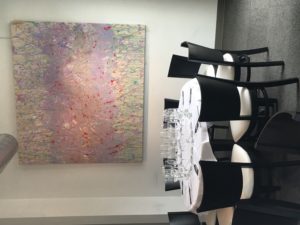
At Senti, Franco Braccia hosted a lovely degustazione of a white Collefrisio di Colleffrisio and a red Montepulciano Vignaquadra d’ Abruzzo with accompaniment and tasting notes. I’ll definitely return to this tempting restaurant for cooking classes and fresh in-house pasta and bread.
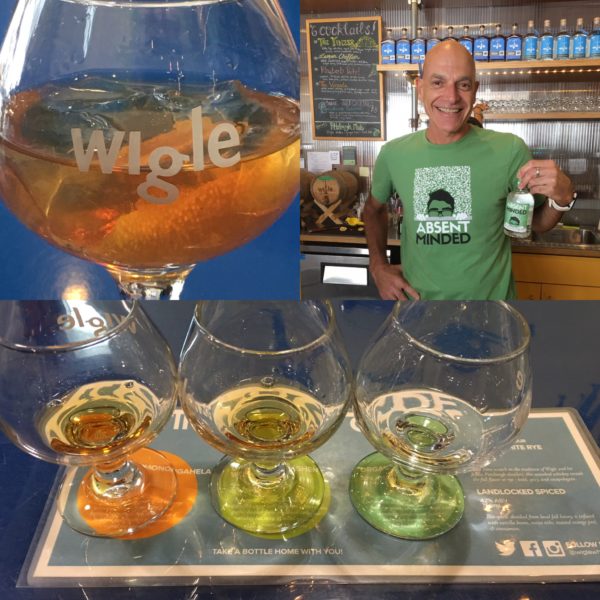 I enjoyed a mean Sazerac while touring Wigle Distillery, a truly spirited environment with a fervor equal to or greater than Pennsylvania’s post-Prohibition distillers.
I enjoyed a mean Sazerac while touring Wigle Distillery, a truly spirited environment with a fervor equal to or greater than Pennsylvania’s post-Prohibition distillers.
Since 2012, the rye whiskey begins with local organic heirloom grain milled to grist, to mash, to fermentation and distillation. In a couple hours, we learn of Pittsburgh’s rebellious path to establish itself as the epicenter of whiskey-making in the late 18th century. Our tasting included a number of Wigle products: gin, honey spirits and bitters. The name is a tribute to Philip Wigle, whose efforts to thwart taxation led to the Whiskey Rebellion.
The 130’ rail ride on the Duquesne Incline may excite youngsters, but it’s the steel and coal mining history and ingenuity that shines in my eyes. At the top: an incomparable birds-eye view of Pittsburgh. The sunset and seafood were  equally spectacular at the Monterey Bay Fish Grotto.
equally spectacular at the Monterey Bay Fish Grotto.
Precision in selection and marriage of exquisite ingredients makes for perfection at The Vandal. My red potato hash (confit onion, hot & sweet peppers, corn and sour cream) topped with an egg was WOW. So was a neighbor’s griddled sourdough with frangipani cream and fruit compote. And my other neighbor’s insane biscuit sandwich. And Csilla’s granola…
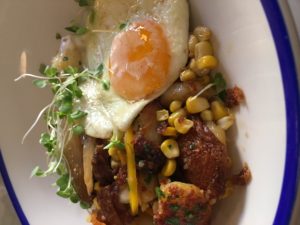
For uniqueness and eyes on humanity, my PGH faves are many: Smallman Galley, Conflict Kitchen, the Nationality Rooms, strolling the Strip, Wigle, the Duquesne funicular and view from the top, and The Vandal.
Pittsburgh, you’ve grown so!

When you go
Hotel Monaco Pittsburgh, a Kimpton Hotel: http://www.monaco-pittsburgh.com/
Smallman Galley: http://www.smallmangalley.org/
Molly’s Trolleys: http://www.mollystrolleyspittsburgh.com/
ReNew Festival: http://renewfestival.com/about/drap-art/
Segway Pittsburgh: segwaypittsburgh.com
‘Burgh, Bits & Bites Food Tour: http://burghfoodtour.com/tours/
Nationality Rooms, U Pittsburgh: http://www.nationalityrooms.pitt.edu/about/cathedral-learning
Conflict Kitchen: http://conflictkitchen.org/
Wigle Distillery: wiglewhiskey.com
Duquesne Incline: http://www.duquesneincline.org/
The Vandal: http://www.thevandalpgh.com/
Note: The author was one of a group of IFWTWA (International Food, Wine & Travel Writers Association) journalists hosted by VisitPittsburgh.

